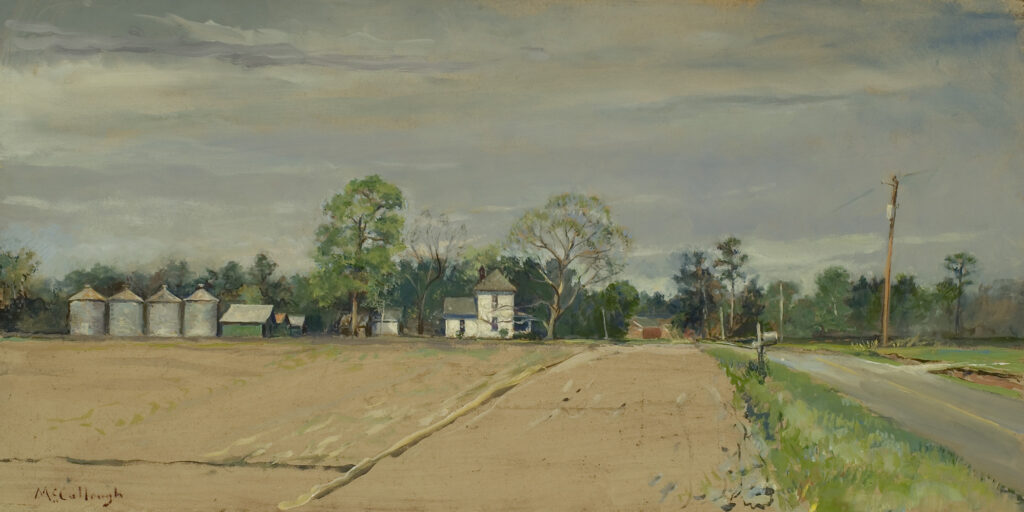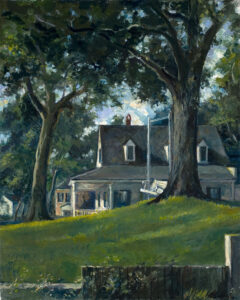William McCullough elevates the common through art.
Featured Image: Self Portrait, by William McCullough, 2002
By Eliza Chapman Bailey
Photographs of McCullough’s Work Courtesy of Currie McCullough
South Carolina is a series of small towns and farming communities. These towns harken to a simpler past, where the interplay of light, colors, structures, and livestock creates a slow-paced ease. They are centered on land, sustenance, and people and represent a unique underlying agrarian grit that defines the Southern ethos. It is this spirit that William Watson “Bill” McCullough (1948-2022) carried with him when he boarded a train in the late 1960s to study at the National Academy of Art and Design in New York to become a Southern Painter.

McCullough was born in 1948 near Kingstree on a parcel of land granted to his forefathers in the mid-1700s. The son of tobacco farmers Watson and Dorothy McCullough, he showed an artistic aptitude at a young age, drawing and painting his surroundings without embellishments. His kinship with the land and its people resonated with the aquarian traditions of realism,which is the opposite of the post-modern movement. The lineage of his classically trained education to the French Barbizon Painters, who left the confines of the classroom to shed light on and paint the beauty of everyday life, is direct and can be found in his studies: McCullough was taught by Robert Bachman (1898-1980) at the National Academy of Art/Arts Student League in New York; Bachman’s teacher was Robert Henri(1865-1929) from the Ashcan School, Henri’s influence was Jean-Francios Millet (1814-1875) founder of the Barbizon School.

While his classmates were focused on postmodernism, McCullough painted figures and represented subject matters truthfully without idealization, distortion, or exaggerated emotion. He immersed himself in the art scene, spending much time in museums and galleries and studying original masterpieces. In the book William McCullough, Southern Painter, in conversation with William Baldwin, Southern Writer, McCullough emphasizes the importance of seeing an original versus a print copy to capture its style accurately. “A plate in a book is very different from a real painting,” he continues, “Using colors in a certain way. People think they are painting classically, but they are not. They haven’t seen the real painting. Only a reproduction.”

McCullough relocated to the Appalachian Mountains of North Carolina, where he honed his skills in landscape and still-life painting. In the 80s, the lure of the Lowcountry’s landscape prompted a move to Charleston. During his time in Charleston, he taught at the Gibbes Museum Studio and earned national recognition for his work. Brad Collins, Profession of Art History at the University of South Carolina, says, “While the so-called post-modernists heirs of the modernists continue to pursue novelty, realists such as McCullough would prefer to remind us of the extraordinary beauty of light on the side of a house. In a time when the survival of this lovely little blue planet has come into question, this is not an insignificant thing.” Locally, his work hangs at the prestigious Cassique clubhouse at Kiawah Island, Roper St. Francis Hospital, and the Gibbes Museum of Art. His works are also housed in the permanent collections of the Ogden Museum of Southern Art in New Orleans, The Greenville County Museum of Art in Greenville, South Carolina, and private collections.


McCullough’s art is not just a reflection of Southern culture but a part of it. Like the church and the tobacco fields outside the windows in his painting, ‘Broadman Hymnal,’ his work seamlessly weaves the fabric of Southern culture with realism. His daughter, Currie McCullough, echoes this sentiment, “My father was influenced by realistic painters who represented the world with accuracy and detail. While other contemporary artists have employed realism techniques in their works, he is the only artist I know of from South Carolina who used these techniques to depict rural South Carolina and capture the character of small towns in his work.” Continuing his legacy, Currie endeavors to establish the McCullough Arts Foundation to sponsor artists’ retreats at his farm in Cedar Swamp and his studio in Pougnadoresse, France.





